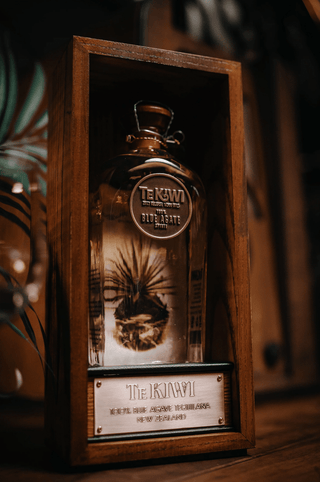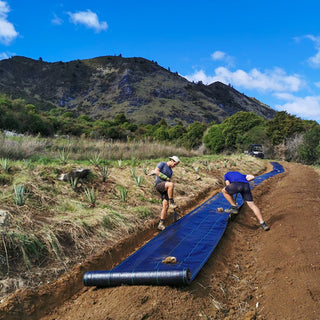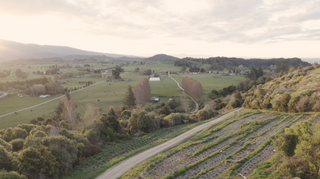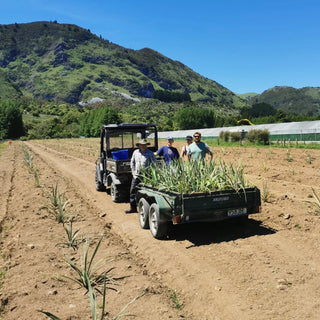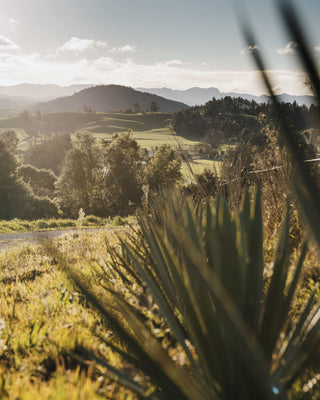
Agave and Aotearoa: A Growing Story
In the rolling green pastures of Golden Bay, among dairy farms and orchards, something unexpected grows. Spiky, silver-blue rosettes stand tall under the New Zealand sky: Weber Blue Agave Tequilana plants thriving here at Kiwi Spirit Distillery – the only place in New Zealand where these remarkable plants are grown.
Before we dive into how this came to be, it’s worth understanding the life cycle of Weber Blue Agave Tequilana, the only plant used to make Tequila in Mexico. These iconic plants grow for six to eight years – sometimes even longer – before reaching maturity. Throughout their lives, they store energy in their large, spiky leaves, channeling it into the heart of the plant. When mature, they produce a single towering flower stalk, after which the plant dies. Traditionally, for spirits production, the plants are harvested just before they flower, when their sugar content is at its peak. The entire plant is dug out and harvested, meaning it’s an eight-year wait – and then you start again.
However, each plant produces “pups” or offshoots at its base throughout its life. These pups can be separated and replanted to become the next generation, allowing the cycle to continue.
How these agave plants first arrived in New Zealand is a story full of speculation and lore. One day we will tell that tale. For now, what matters is this: in 2015, we were lucky enough to harvest mature Weber Blue Agave plants grown right here in Golden Bay. From these, we crafted the country’s very first Weber Blue Agave Tequilana spirit – TeKiwi.
After that first harvest, we took the pups (young plants) and replanted them on our brand-new 25 acre property in Motupipi, that would later become Kiwi Spirit Distillery. Growing agave in large quantities has been an adventure, to say the least.
Our first planting went into what we now know was quite a wet corner of the land. The young plants struggled with damp roots and heavy frosts. When our neighbour’s cows broke through the fence and munched to their hearts’ content, we accepted that the first planting had failed. But giving up has never been our way. From the few remaining pups, we created tissue cultures to build our numbers back up again.
Next, we hedged our bets. We grew the pups inside in a nursery until they were over a year old and strong. We invested in a huge 2,000sqm tunnel house, planting the rows of agave under controlled conditions with a full watering system and wet matting. The plants grew well in their high-tech home, but it wasn’t perfect. The wet matting proved impractical as pups pushed up through it, and the watering system and plastic tunnel house felt like overkill for a plant evolved to thrive in arid deserts.
So, we kept experimenting. During Covid, we planted a small test patch up on our hill block – just to see what would happen. We used pups that had started sprouting from our tunnel house agave; the need to tissue culture was no more once the mature agave began sending up hundreds of pups each year. To our delight and surprise, the pups flourished up on the hillside. Encouraged, we terraced a large paddock and planted a few thousand more. These plants are thriving: frost is kept at bay by the slopes, and drainage is no longer an issue.
However, Golden Bay’s lush dairy-country grass posed a major challenge. The wet matting suppressed the grass somewhat, but emerging pups disrupted it, and weeding at least three times a year was a monumental task plus becoming dangerous given the spiky leaves. Committed to chemical-free growing, pesticides were never an option.
This year, we decided to try something entirely different. We planted over 700 plants on our flat paddocks, creating slightly raised beds angled for good water runoff. This time, we used no wet matting at all. Instead, we fenced the area for sheep to manage the grass naturally. We also took a new approach to soil health: for the first time, we tested and remineralised the soil, balancing minerals like calcium and magnesium using natural local dolomite rock alongside other trace minerals in their natural forms.
It’s now the first winter for these little pups. Looking back, we’ve learned that reducing water pooling and keeping grass at bay seem to be the magic recipe for these desert-born plants to grow all the way down here at the bottom of the South Pacific.
Here in New Zealand, there are no rules to lean on – there isn’t a long history of propagating these plants in this environment that we can replicate. We are doing everything for the first time, relying on intuition, experimentation, and the advice of clever minds to formulate our plans.
Weber Blue Agave Tequilana is the only agave species used to make tequila, which by law can only be produced in designated regions of Mexico. Our spirit is therefore not Tequila. It is something different: an expression of Weber Blue Agave Tequilana nurtured by the sun and rain of Golden Bay, crafted and distilled into a spirit that’s uniquely ours, uniquely Kiwi.
The journey of creating TeKiwi 100% Blue Agave Tequilana Spirit has been as extraordinary as its taste. And now, with thousands of plants almost ready for harvest, this story is only just beginning.
